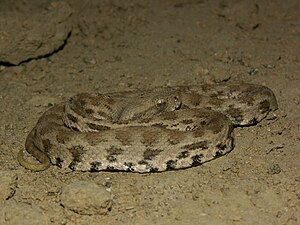Grand vipers
| Grand vipers | ||||||||||||
|---|---|---|---|---|---|---|---|---|---|---|---|---|

Levant Otter ( Macroektivena lebetina ) |
||||||||||||
| Systematics | ||||||||||||
|
||||||||||||
| Scientific name | ||||||||||||
| Macroilota | ||||||||||||
| Reuss , 1927 |
The great vipers ( Macrophia ) are a genus of real vipers that currently contains two species: the better-known Levant otter ( Macrophia lebetina ) and the Cycladic viper ( Macroypena schweizeri ), which is endemic to a few islands in the Aegean Sea . Grand vipers, like all vipers, are poisonous; however, the bite is fatal to humans only in exceptional cases.
features
The species of large vipers are on average 80 to 100 centimeters long, but especially the Levant otter can regionally reach lengths of 160 centimeters (proven for Turkmenistan ) with a maximum weight of about 2.7 kilograms. The females are usually slightly larger than the males.
distribution
The grand vipers live mainly in the Middle East . The Levant Otter has the largest distribution area, which it populates with several subspecies: The nominate form M. l. lebetina is found in Cyprus and on the coasts of Turkey . M. l. Obtusa is distributed from Israel via Eastern Turkey and Transcaucasia to Afghanistan and West Pakistan . M. l. turanica and M. l. cernovi are found from Kazakhstan to northern Iran , northern Afghanistan, northwestern Pakistan and western Kashmir . Endemic is separated from the other subspecies in North Africa in Tunisia and Algeria occurring M. l. transmediterranea . Further, not recognized subspecies are M. l. euphratica from Turkey and M. l. bearing from southern Afghanistan and northern Pakistan. The Cycladic viper ( Macrophia schweizeri ) lives as an endemic island inhabitant in the Milos archipelago and probably also on the island of Kythnos in the Aegean Sea.
Systematics
The grand vipers have long been classified in the genus of the real vipers ( Vipera ), together with most other European vipers. In 1992, the genus was revised, in which the four species, which are now counted among the great vipers, were classified in the genus Macroektivena on the basis of biochemical characteristics . The Cycladic viper ( Macroypena schweizeri ), which had previously been regarded as a subspecies of the Levant otter , was also recognized as a separate species and described as a sister species of the Levant otter. The two North African species of the Sahara otter ( Macrophia deserti ) and Atlas otter ( Macroektivena mauretanica ) completed the genus.
By Lenk et al. In 2001, however, this compilation was questioned. On a molecular biological basis, the sister group relationship of Levant otter and Cycladic viper can be maintained, the African species, on the other hand, are closely related to the chain viper ( Daboia russelii ) and the Palestinian viper ( Daboia palaestinae ), which is why the African macro vipera and the Palestine viper were assigned to the genus Daboia suggested. Accordingly, only the Levant otter and the Cycladic viper belong to the genus Macroocket .
|
|
|
|||||||||||||||||||||||||||
|
|
This view is confirmed by Garrigues et al. 2004, in which the vipers form a European section from different Vipera species as well as an oriental section from the named genera Daboia and Macroypena and the Montivipera species. As with Lenk et al. In 2001 the genus of large vipers, including the two African species, is paraphyletic. The chain viper ( Daboia russeli ) forms a taxon with the Palestine viper and the atlas viper ( the Sahara otter and the Cycladic viper were not part of the investigation). Mallow et al. 2003 accordingly classified the Palestine otter in the genus, the Atlas otter was named by Wüster et al. based on the results of Lenk et al. put to Daboia .
swell
Sources cited
Most of the information in this article has been taken from the sources given under literature; the following sources are also cited:
- ↑ H.-W. Herrmann, U. Joger, G. Nilson: Phylogeny and systematics of viperine snakes. III: resurrection of the genus Macroektivena (Reuss, 1927) as suggested by biochemical evidence. In: Amphibia-Reptilia. 13, 1992, pp. 375-392.
- ↑ P. Lenk, S. Kalayabina, M. Wink, U. Joger: Evolutionary relationships among the true vipers (Reptilia: Viperidae) inferred from mitochondrial DNA sequences. In: Molecular Phylogenetics and Evolution. 19, 2001, pp. 94-104. ( Full text PDF )
- ↑ Thomas Garrigues, Catherine Dauga, Elisabeth Ferquel, Valérie Choumet, Anna-Bella Failloux: Molecular phylogeny of Vipera Laurenti, 1768 and the related genera Macrophia (Reuss, 1927) and Daboia (Gray, 1842), with comments about neurotoxic Vipera aspis aspis populations. In: Molecular Phylogenetics and Evolution. 35 (1), 2005, pp. 35-47.
- ↑ David Mallow, David Ludwig, Göran Nilson: True Vipers. Natural History and Toxinology of Old World Vipers. Krieger Publishing Company, Malabar, Florida 2003, ISBN 0-89464-877-2 , pp. 141-159.
- ↑ Wolfgang Wüster, Lindsay Peppin, Catharine E. Pook, Daniel E. Walker: A nesting of vipers: Phylogeny and historical biogeography of the Viperidae (Squamata: Serpentes). In: Molecular Phylogenetics and Evolution. 49, 2008, pp. 445-459.
literature
- Ulrich Joger, Nikolaus Stümpel: Macrophia Reuss, 1927. In: Ulrich Joger, Nikolaus Stümpel: Handbook of the reptiles and amphibians of Europe. Volume 3 / IIB: Snakes (Serpentes) III Viperidae. Aula-Verlag, Wiebelsheim 2005, ISBN 3-89104-617-0 , pp. 23-24.
- David Mallow, David Ludwig, Göran Nilson: True Vipers. Natural History and Toxinology of Old World Vipers. Krieger Publishing Company, Malabar, Florida 2003, ISBN 0-89464-877-2 , pp. 193-204.